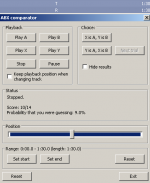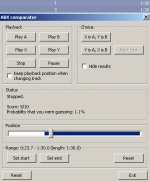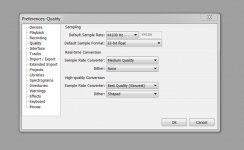The big problem of inverting circuit is that:
1) it has low input impedance defined by the resistor from input to inverting input of the opamp
2) this resistor connected to -IN introduces additional noise, acceptable value is 1kohm or less but then we have low input impedance. And in case of higher gain this noise is amplified by the gain used. So, inverting without buffer before it is difficult to make well.
Is the low impedance really an issue though, given that most source components can drive at least 10k without issue.
I know that we differ greatly here on our viewpoints 🙂
For me, absolute noise levels are not something I would pursue once it becomes essentially inaudible. I have two inverting OPA2134's in my present amp and noise (hiss) is minimal even when the volume is on full. Beyond a few cm from the tweeter and you can't hear it. Switch a source component on (such as the Sony MiniDisc) and the hiss contribution from that dominates. The Marantz much less so, but it still adds noticeable "hiss". But that's on full volume, the reality is the preamps contribution is inaudible. So worsening an overall noise figure by manipulation of noise gain isn't to me an issue if there are other more tangible benefits.
I have a particular interest in the inverting configuration because I favour solid state switching for small signal (and speaker) and the inverting opamp allows switching elements to be placed at the virtual earth point minimising their non linearity.
For me it is a balancing act, a juggling act, in getting the overall listening experience to be one I like and that works well with much source material.
Yes, that's why system should be designed integral from source to speaker.
In this case, we have the possibility to remove the so called "preamp". Focus more on the output stage of a DAC chip and find a best way to insert a volume control.
The blind test shows that opamp insertion is detrimental to sound quality. So opamp should be used wisely. The effect to enjoyment is long term actually, cannot be perceived on the spot like in a blind test (you have to live with both options then you will know).
To me its "how it all comes together" in the final listening experience.
What do you think to the fact that most of what we hear has been through many opamps already.
What do you think to the fact that most of what we hear has been through many opamps already.
I have mentioned many times that, in general, it has no relevance. Just like how "distortion" is collected/amplified through a series of amplifying stages.
Just like in our blind test. Two opamps are used as a buffer. Additional two opamps will make it worse. And all of them (these test files) are clearly unacceptable.
Is the low impedance really an issue though, given that most source components can drive at least 10k without issue.
I know that we differ greatly here on our viewpoints 🙂
Talking about power opamps, it IS an issue. I'm not talking from technical point of view. I'm talking from my experience trying to build the best of both inverting and non-inverting, trying all possible combinations.
From our tests we can see that sonic is very important, even if distortion is higher.
........ And all of them (these test files) are clearly unacceptable.
Technical quality or musical content ?
I might try comparing a direct WAV file with one replayed through the CD player and AD convertor for interest.
How do you match levels between two files without affecting quality ?
Hi Karl, I am with Jay here, it is very difficult to assess quality of anything that goes out of the analog output of the CD player and then it is digitized with 16-bit precision.
For quick study, I converted 'mike' and 'kiwi' to 16bit. Noise differences are easier to differentiate. Kiwi became a little more noisy, mike became significantly more noisy proportionate to kiwi.
But I am posting 24-bit files intentionally, especially if I use lower than full amplitude range. Your manipulation with files to 16-bit ones is a signal degradation and as such I must not take into account your results obtained with manipulated 16-bit files.
Hi Karl, I am with Jay here, it is very difficult to assess quality of anything that goes out of the analog output of the CD player and then it is digitized with 16-bit precision.
Fair comment... and I'm showing my ignorance now. With Audacity that I used to capture the files I do have 24 bit as an option. These are the default setting I have used.
Attachments
32 bit float is perfect. The key is when you save files. You can save them as 16 bit or 24 bit. You also should say your card in the card driver which resolution it should use. And then it is good to make loopback test with 24-bit test file to make sure your card really works at 24-bit resolution. You may also download my 'sigtest110', 24bit -110dBFS sine.
No perfect score:

Mindset comes in and out, but when it clicks the difference seems sharp. I guess when this happens, it's best to hit the stop button and take a break.
Maybe listening to it while sleeping really sticks a version into the head hard.
Here I got three hits in a row, then started missing.

Mindset comes in and out, but when it clicks the difference seems sharp. I guess when this happens, it's best to hit the stop button and take a break.
Maybe listening to it while sleeping really sticks a version into the head hard.
Here I got three hits in a row, then started missing.
That's good. I see you were listening to T and R, the inverting buffers and inverting buffers plus the 100% nfb buffers in that ABX run.
Any preference sonically for one over the other 😀
Any preference sonically for one over the other 😀
Both, if I got you right.Technical quality or musical content ?
I might try comparing a direct WAV file with one replayed through the CD player and AD convertor for interest.
How do you match levels between two files without affecting quality ?
I think what important is to treat them equally. So it is okay to degrade the files by adding buffers before or after the "volume control". It is necessary for the DUT to operate in their intended position in the system chain (regarding impedance matching at both input and output).
Both, if I got you right.
Oh 😀 OK then.
I think what important is to treat them equally. So it is okay to degrade the files by adding buffers before or after the "volume control". It is necessary for the DUT to operate in their intended position in the system chain (regarding impedance matching at both input and output).
I tried having a play with 48k/24bit files in Audacity and comparing to 44.1/16bit. I didn't have a serious ABX attempt with them, both sounding pretty similar with a casual listen.
I was hoping to have been able to play them direct on the Marantz SACD (using its USB input) put got the "file header error" with the 48k one so it seems its just not compatible on that score.
I realise the hardware I have is a limitation. A ripped 250 + 8050kHz signal looked quite respectable in Audacity with an FFT plot. The same track going through the A/D had various artifacts clearly visible.
All the tests have been very worthwhile though because as you say, all were treated equally... the same hardware limitations being present for all the files.
It has been good 🙂
ABX T v S
ABX T v S:

I find my own performance hard to believe. If difference is apparent, it is right after switching. A few seconds of A, then X or Y, then answer or stop. After answer or stop, pause before next trial.
No way to make preference. Bad choices are often made this way in showrooms. Extended listening with diverse music selection
ABX T v S:

I find my own performance hard to believe. If difference is apparent, it is right after switching. A few seconds of A, then X or Y, then answer or stop. After answer or stop, pause before next trial.
No way to make preference. Bad choices are often made this way in showrooms. Extended listening with diverse music selection
ABX T v S:
I find my own performance hard to believe.
I told ya! It's the only pair I can differentiate with 100% confidence. The reason I believe is:
1) the two opamS with 100% feedback make the sound THIN.
2) the two opamps with resistor trick make the sound FAT (due to noise?).
So it is very very easy to differentiate. Thin versus fat.
No way to make preference. Bad choices are often made this way in showrooms. Extended listening with diverse music selection
With RST all files are not worth listening so it may be difficult to choose (tho my first reflex is always towards direct). But listening to LMN, it is obvious that only one file stand out. It is L with accurate brush sound and tolerable noise. M is clearly messy here.
- Status
- Not open for further replies.
- Home
- General Interest
- Everything Else
- Small Signal Listening Comparison Test
